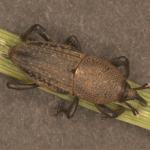Annual bluegrass weevils
Growing degree day (GDD) accumulation in Massachusetts and northern Connecticut had a jump start in early March and increased relatively steadily, with occasional cool spells, for most of our locations. By the end of March 25-40 GDDs were accumulated, and by the end of April 104-120 GDDs were accumulated. By the end of last week (May 20th) most locations had accumulated 250-286 GDDs. Soil temperatures did not reach the 50s until the first week of May.
ABW development so far has been very close to “usual”, in spite of the periods of somewhat cooler temperatures, with no significant delays or other surprises. Very clear peaks of adult activity were observed, with expected larval development. Adult activity peaked during the last week of April – first week of May. First larvae were observed on May 10-11 and as of this writing first, second, and few third instars have been observed in turf samples. Average larval development ranged from ~1.65 to 2nd instar by the end of last week. Growing degree days and plant phenology were in accordance with weevil adult activity (Forsythia half green/half gold and ~100-120 GDDs). However, GDD accumulations were lower at our coastal site (in Swampscott MA), even though the ABW development was very similar to that observed at other locations.
Rapid GDD accumulation occurred the week of May 16 (~100 GDDs, ~15-20 per day), suggesting rather fast ABW development. Insect development might be expected to intensify when temperatures are higher, but often during “heat waves” (when the temperature reaches > 95˚F) temperatures increase above the optimum for insect development and therefore accelerated development is not always observed, especially in temperate climates. Temperatures in western Massachusetts were in the 90s over the weekend and have now cooled back down to the 50s -70s.
While there was a large accumulation of GDDs over the weekend, insect development needs to be monitored to make a sound management decision. Hybrid Catawba Rhododendron is not in full bloom yet, but the GDD accumulations will be fast reaching 300-400 GDDs. Therefore, the timing for larvicide applications targeting older larvae (~2.5 instar) that feed outside of the grass plant is just around the corner. The optimal timing for late larvicides is usually marked by three indicators coming together: plant phenology (full bloom Rhododendron), GDDs (>300), and average larval instar (~2.5 - 3). If population densities are high, the first signs of damage might become visible in a week or two, however the most damage is expected later, in June.
Craneflies
Flight of common craneflies, Tipula oleracea, was reported in Massachusetts during the last week of April – first week of May (Figure 1). Larvae of this invasive species can be damaging to turfgrass, especially if the spring is wet or in areas with poor drainage. Adults that resemble giant mosquitoes can be a nuisance, but they do not cause turf damage nor do they cause harm to people or pets. They have reduced or absent mouthparts and they do not feed, or feed only on nectar. The conditions this spring are rather dry for cranefly eggs and first instar survival, therefore we do not expect significant damage this season. However, poorly drained areas in particular might support high cranefly population densities.
Billbugs
We continue monitoring phenology of the billbug species complex in western and eastern Massachusetts. Bluegrass billbug (Sphenophorous parvulus, Fig. 2) and lesser billbug (S. minimus) adults started their movement from overwintering sites and have been found in traps since the first week of May. Recently their numbersare increasing rapidly, suggesting that they will peak soon. One of the approaches to manage billbug populations is to target adults with fast acting and contact insecticides, such as pyrethroids (bifenthrin, lambda-cyhalothrin, deltamethrin and others). This approach provides only reduction of the population; overall it is not very effective. However, if the high population densities were detected the previous year, it might be necessary to include billbugs in the management program. It is important to monitor adults to predict the timing of other billbug life stages, even if an adulticide application is not planned.
Submitted by: Dr. Olga Kostromytska

